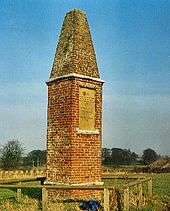Wold Cottage meteorite
| Wold Cottage | |
|---|---|
|
On display in the Natural History Museum, London | |
| Type | Chondrite |
| Class | Ordinary chondrite |
| Group | L6 |
| Country | United Kingdom |
| Region | Yorkshire, England |
| Coordinates | 54°8′02.4″N 0°24′45.3″W / 54.134000°N 0.412583°WCoordinates: 54°8′02.4″N 0°24′45.3″W / 54.134000°N 0.412583°W[1] |
| Observed fall | Yes |
| Fall date | 13 December 1795, 3 p.m. |
| TKW | 56 lb (25 kg) |
The Wold Cottage meteorite (also called the Wold Newton meteorite) fell near Wold Cottage farm in 1795, a few miles away from the hamlet of Wold Newton in Yorkshire, England.
The meteorite
The stone fell at around 3 o'clock, on 13 December 1795. It created a crater approximately 1 yard (0.91 m) across, and embedded itself in the underlying chalk rock to a depth of 7 inches (180 mm), passing through 12 inches (300 mm) of topsoil. The fall was observed by several people, who described a dark body passing through the air.[2] As discovered at its landing point, the stone was warm and smoking; several people reported sounds of explosions as it fell.[3] The owner of the land was Major Edward Topham, a well-known public figure, an ex-soldier, playwright and newspaper proprietor; he publicised the find and exhibited the meteorite publicly at Piccadilly in London.[4][5]
The stone initially weighed 56 pounds (25 kg).[6] James Sowerby, a naturalist, acquired the meteorite in 1804.[4] The meteorite was later acquired by the British Museum in 1835.[4][7]
The meteorite can nowadays be seen in the Natural History Museum in London.
Analysis and research
Early analyses recorded two parts of the stone, an earthy part, and a malleable part. The earthy part analysed as containing silicon, magnesium, iron, and a small amount of nickel, of which some parts of the iron and nickel were in the elemental state; the earthy substance was similar to kaolin (weathered feldspar), but relatively tough. The malleable parts also contained iron and nickel, the majority iron. A form of iron pyrites (iron sulphur compound) was also reported present.[8][9] Modern science records the meteorite as a L6 ordinary chondrite.[1]
The Wold Cottage meteorite was the largest meteorite observed to fall in Britain, and is the second-largest recorded in Europe (after the Ensisheim meteorite).[4] The meteorite and evidence given about its fall contributed to the debate concerning whether extraterrestrial matter existed or not, and towards the early scientific study of meteorites.[10][11][12]
The monument

| Inscription |
|---|
| Here |
| On this Spot, Decr. 13th, 1795 |
| Fell from the Atmoſphere |
| AN EXTRAORDINARY STONE |
| In Breadth 28 inches |
| In Length 36 inches |
| and |
| Whoſe Weight was 56 pounds. |
| ---- |
| THIS COLUMN |
| In Memory of it |
| Was erected by |
| EDWARD TOPHAM |
| 1799 |
A monument was erected on the location of the stone's impact, by Major Topham, on whose property the stone had fallen.[13] The structure was built of brick 4 ft (1.2 m) square and 25 ft (7.6 m) high, with a plaque on one face.[14]
In fiction
The event was used by the science fiction writer Philip José Farmer in his "biographies" of fictional characters (Tarzan Alive and Doc Savage: His Apocalyptic Life) as the basis for a literary premise commonly referred to as the Wold Newton family. The film Robinson in Ruins would also refer to the event, with the main character, Robinson, seeing it showing meteorites always fall at the time of significant events, in this case the 1795 amendment to the Settlement Act which allowed capitalism to develop faster in England.
See also
Notes
- 1 2 Meteoritical Bulletin Database: Wold Cottage
- ↑ Sowerby 1806, pp. 5–6.
- ↑ Sowerby 1806, pp. 18–19.
- 1 2 3 4 Marvin, U.B. (2006). "Meteorites in history: an overview from the Renaissance". In McCall, G.J.H.; Bowden, A.J.; Howarth, R.J. The History of Meteoritics and Key Meteorite Collections: Fireballs, Falls and Finds. Geological Society. pp. 39–40. ISBN 1-86239-194-7.
- ↑ Pillinger & Pillinger 1996.
- ↑ Sowerby 1806, p. 6.
- ↑ "SOWERBY, JAMES (1757–1822)". The Vauxhall Society. Archived from the original on 24 January 2008. Retrieved 13 November 2012.
- ↑ Sowerby 1806, p. 18.
- ↑ Howard, E.; Williams, J. L.; De Bournon, C. (1802). "Experiments and Observations on Certain Stony and Metalline Substances, Which at Different Times are Said to Have Fallen on the Earth; Also on Various Kinds of Native Iron" (PDF). Philosophical Transactions of the Royal Society of London. 92: 168. doi:10.1098/rstl.1802.0009.
- ↑ Sources:
- Elliott, Robert. "The Wold Cottage & It's Meteorite". Retrieved 13 November 2012.
- Bostick, Mark. "Early Meteorite Falls". The Wold Cottage Fall. Archived from the original on 9 August 2007. Retrieved 13 November 2012.
- ↑ Pillinger & Pillinger 1996a.
- ↑ Pillinger & Pillinger 1998.
- ↑ Sowerby 1806, p. 7.
- ↑ Historic England. "Commemorative monument recording fall of a meteorite, erected 1799 (79897)". PastScape. Retrieved 13 November 2012.
Literature
- Pillinger, C. T.; Pillinger, J. M. (January 1996), "The Value of Publicity—The Wold Cottage Chondrite, Edward Topham, and the Foundation of Meteoritics", Meteoritics & Planetary Science, 31: A108, Bibcode:1996M&PSA..31Q.108P, doi:10.1111/j.1945-5100.1996.tb02098.x
- Pillinger, C. T.; Pillinger, J. M. (August 1996a), "The Wold Cottage meteorite: Not just any ordinary chondrite", Meteoritics, 31 (5): 589–605, Bibcode:1996M&PS...31..589P, doi:10.1111/j.1945-5100.1996.tb02032.x
- Pillinger, C. T.; Pillinger, J. M. (July 1998), "Wold Cottage and Its Influence on Reports of the Pettiswood and Evora Meteorites", Meteoritics & Planetary Science, 33: A123, Bibcode:1998M&PSA..33Q.123P, doi:10.1111/j.1945-5100.1998.tb01327.x
- Sowerby, James (1806), "Tab. CI. FERRUM nativum. Meteroic Iron", British mineralogy, or, Coloured figures intended to elucidate the mineralogy of Great Britain, 2, pp. 1–19
External links
| Wikimedia Commons has media related to Wold Cottage meteorite. |
- "(search) "Wold"", piclib.nhm.ac.uk, Natural History Museum, Images related to the Wold Cottage Meteorite and monument